wheel VAUXHALL MOVANO_B 2020 Owner's Manual
[x] Cancel search | Manufacturer: VAUXHALL, Model Year: 2020, Model line: MOVANO_B, Model: VAUXHALL MOVANO_B 2020Pages: 351, PDF Size: 9.32 MB
Page 12 of 351
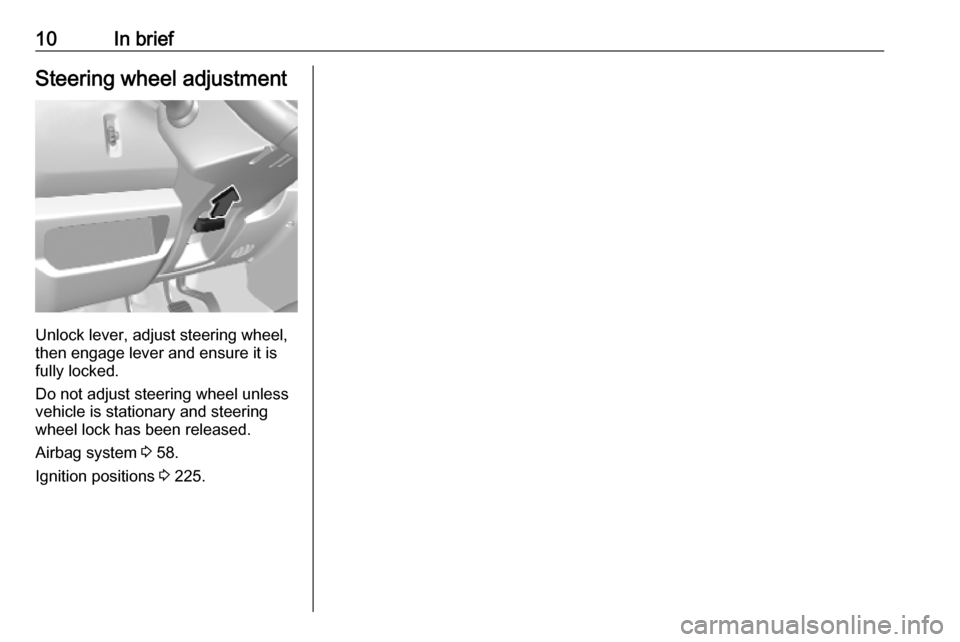
10In briefSteering wheel adjustment
Unlock lever, adjust steering wheel,
then engage lever and ensure it is fully locked.
Do not adjust steering wheel unless
vehicle is stationary and steering
wheel lock has been released.
Airbag system 3 58.
Ignition positions 3 225.
Page 14 of 351

12In brief1Side air vents ...................... 220
2 Light switch ........................ 109
Turn lights ........................... 112
Front / rear fog lights ..........112
Headlight flash ....................111
High beam ........................... 110
High beam assist ...............110
Exit lighting ......................... 115
3 Horn ..................................... 84
Driver airbag ......................... 61
4 Instruments .......................... 90
Driver Information Centre .... 104
5 Windscreen wiper and
washer, rear wiper and
washer ................................. 85
Buttons for Driver
Information Centre ..............104
6 Air vents ............................. 220
7 Info Display ........................ 104
8 USB socket, AUX socket,
SD card slot .......................... 87
9 Storage ................................. 7210Cupholder ............................. 73
11 Tray ....................................... 72
12 Glovebox .............................. 73
13 Parking assist ...................... 254
Lane departure warning ......260
Electronic Stability Control
and Traction Control ...........246
Hazard warning flashers ....112
Central locking system ..........23
Stop-start system ................227
Side blind spot alert ............256
ECO mode .......................... 224
14 Inductive charging .................89
15 Climate control system ........ 207
16 Power outlet .......................... 87
17 Cruise control .....................248
Speed limiter ....................... 250
18 Manual transmission ..........240
Manual transmission
automated .......................... 240
19 Ignition switch .....................22520Infotainment controls
21 Steering wheel adjustment ..84
22 Bonnet release lever ..........269
23 Fuse box ............................ 286
24 Headlight range
adjustment ......................... 111
25 Power take-off .....................265
Idle speed control ...............227
Laden mode kg ...................242
Page 19 of 351
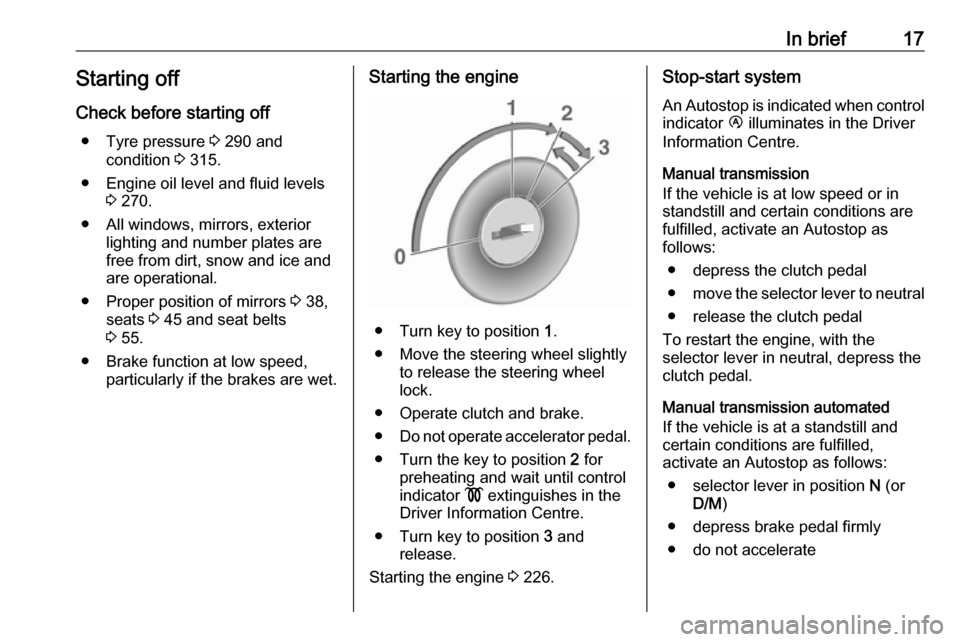
In brief17Starting offCheck before starting off ● Tyre pressure 3 290 and
condition 3 315.
● Engine oil level and fluid levels 3 270.
● All windows, mirrors, exterior lighting and number plates are
free from dirt, snow and ice and
are operational.
● Proper position of mirrors 3 38,
seats 3 45 and seat belts
3 55.
● Brake function at low speed, particularly if the brakes are wet.Starting the engine
● Turn key to position 1.
● Move the steering wheel slightly to release the steering wheel
lock.
● Operate clutch and brake.
● Do not operate accelerator pedal.
● Turn the key to position 2 for
preheating and wait until control
indicator ! extinguishes in the
Driver Information Centre.
● Turn key to position 3 and
release.
Starting the engine 3 226.
Stop-start system
An Autostop is indicated when controlindicator Ï illuminates in the Driver
Information Centre.
Manual transmission
If the vehicle is at low speed or in
standstill and certain conditions are
fulfilled, activate an Autostop as
follows:
● depress the clutch pedal
● move the selector lever to neutral
● release the clutch pedal
To restart the engine, with the
selector lever in neutral, depress the
clutch pedal.
Manual transmission automated
If the vehicle is at a standstill and
certain conditions are fulfilled,
activate an Autostop as follows:
● selector lever in position N (or
D/M )
● depress brake pedal firmly
● do not accelerate
Page 20 of 351
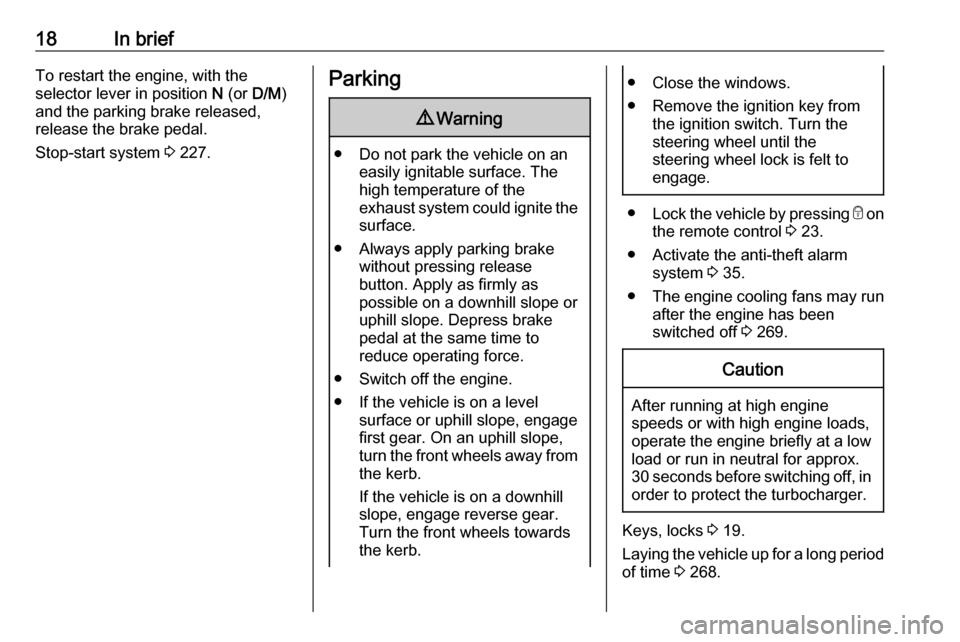
18In briefTo restart the engine, with the
selector lever in position N (or D/M )
and the parking brake released, release the brake pedal.
Stop-start system 3 227.Parking9 Warning
● Do not park the vehicle on an
easily ignitable surface. The
high temperature of the
exhaust system could ignite the
surface.
● Always apply parking brake without pressing release
button. Apply as firmly as
possible on a downhill slope or
uphill slope. Depress brake
pedal at the same time to
reduce operating force.
● Switch off the engine.
● If the vehicle is on a level surface or uphill slope, engage
first gear. On an uphill slope,
turn the front wheels away from
the kerb.
If the vehicle is on a downhill
slope, engage reverse gear.
Turn the front wheels towards the kerb.
● Close the windows.
● Remove the ignition key from the ignition switch. Turn the
steering wheel until the
steering wheel lock is felt to
engage.
● Lock the vehicle by pressing e on
the remote control 3 23.
● Activate the anti-theft alarm system 3 35.
● The engine cooling fans may run
after the engine has been
switched off 3 269.
Caution
After running at high engine
speeds or with high engine loads,
operate the engine briefly at a low load or run in neutral for approx.30 seconds before switching off, in
order to protect the turbocharger.
Keys, locks 3 19.
Laying the vehicle up for a long period
of time 3 268.
Page 22 of 351
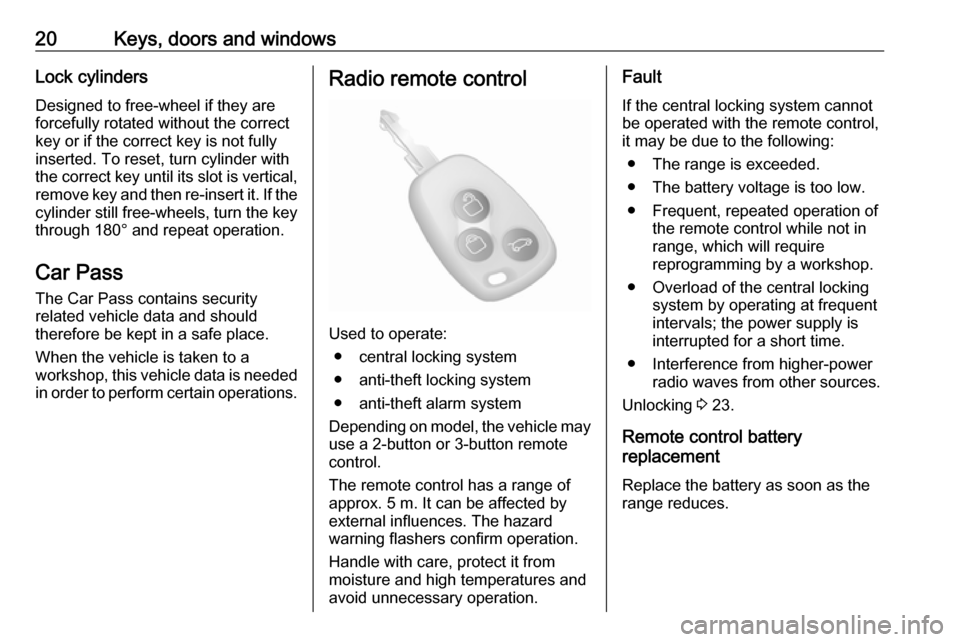
20Keys, doors and windowsLock cylinders
Designed to free-wheel if they are
forcefully rotated without the correct
key or if the correct key is not fully
inserted. To reset, turn cylinder with
the correct key until its slot is vertical, remove key and then re-insert it. If the
cylinder still free-wheels, turn the key through 180° and repeat operation.
Car Pass The Car Pass contains security
related vehicle data and should
therefore be kept in a safe place.
When the vehicle is taken to a
workshop, this vehicle data is needed
in order to perform certain operations.Radio remote control
Used to operate:
● central locking system
● anti-theft locking system
● anti-theft alarm system
Depending on model, the vehicle may use a 2-button or 3-button remote
control.
The remote control has a range of
approx. 5 m. It can be affected by
external influences. The hazard
warning flashers confirm operation.
Handle with care, protect it from
moisture and high temperatures and
avoid unnecessary operation.
Fault
If the central locking system cannot
be operated with the remote control,
it may be due to the following:
● The range is exceeded.
● The battery voltage is too low.
● Frequent, repeated operation of the remote control while not in
range, which will require
reprogramming by a workshop.
● Overload of the central locking system by operating at frequent
intervals; the power supply is
interrupted for a short time.
● Interference from higher-power radio waves from other sources.
Unlocking 3 23.
Remote control battery
replacement
Replace the battery as soon as the
range reduces.
Page 34 of 351
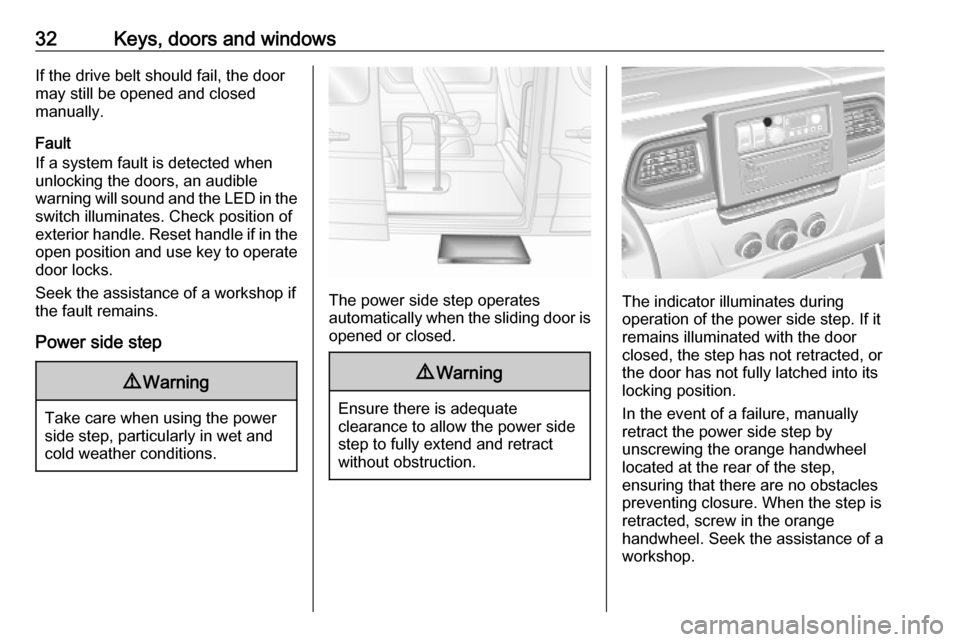
32Keys, doors and windowsIf the drive belt should fail, the door
may still be opened and closed
manually.
Fault
If a system fault is detected when unlocking the doors, an audible
warning will sound and the LED in the switch illuminates. Check position of
exterior handle. Reset handle if in the
open position and use key to operate door locks.
Seek the assistance of a workshop if the fault remains.
Power side step9 Warning
Take care when using the power
side step, particularly in wet and
cold weather conditions.
The power side step operates
automatically when the sliding door is opened or closed.
9 Warning
Ensure there is adequate
clearance to allow the power side
step to fully extend and retract
without obstruction.
The indicator illuminates during
operation of the power side step. If it
remains illuminated with the door
closed, the step has not retracted, or
the door has not fully latched into its
locking position.
In the event of a failure, manually retract the power side step by
unscrewing the orange handwheel
located at the rear of the step,
ensuring that there are no obstacles
preventing closure. When the step is
retracted, screw in the orange
handwheel. Seek the assistance of a
workshop.
Page 47 of 351
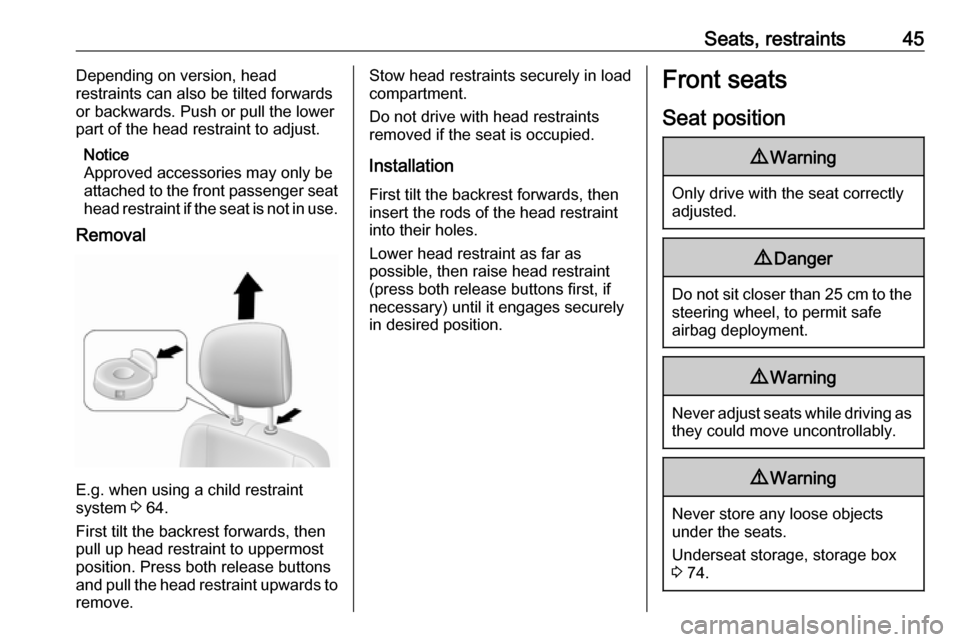
Seats, restraints45Depending on version, head
restraints can also be tilted forwards
or backwards. Push or pull the lower
part of the head restraint to adjust.
Notice
Approved accessories may only be
attached to the front passenger seat
head restraint if the seat is not in use.
Removal
E.g. when using a child restraint
system 3 64.
First tilt the backrest forwards, then
pull up head restraint to uppermost
position. Press both release buttons
and pull the head restraint upwards to remove.
Stow head restraints securely in load
compartment.
Do not drive with head restraints
removed if the seat is occupied.
Installation First tilt the backrest forwards, then
insert the rods of the head restraint into their holes.
Lower head restraint as far as
possible, then raise head restraint (press both release buttons first, if
necessary) until it engages securely
in desired position.Front seats
Seat position9 Warning
Only drive with the seat correctly
adjusted.
9 Danger
Do not sit closer than 25 cm to the
steering wheel, to permit safe
airbag deployment.
9 Warning
Never adjust seats while driving as
they could move uncontrollably.
9 Warning
Never store any loose objects
under the seats.
Underseat storage, storage box 3 74.
Page 48 of 351
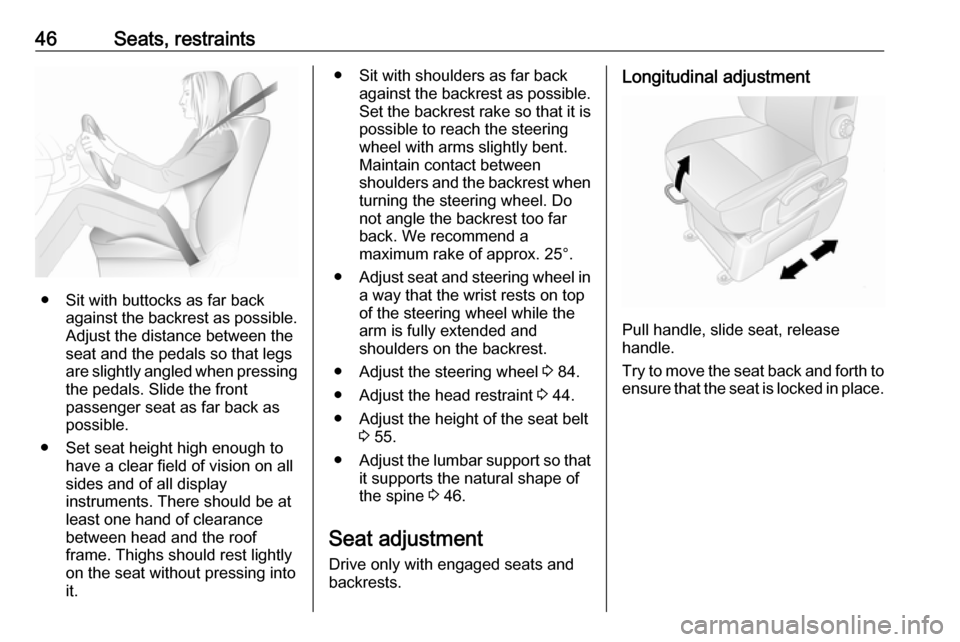
46Seats, restraints
● Sit with buttocks as far backagainst the backrest as possible.
Adjust the distance between the
seat and the pedals so that legs
are slightly angled when pressing
the pedals. Slide the front
passenger seat as far back as
possible.
● Set seat height high enough to have a clear field of vision on allsides and of all display
instruments. There should be at
least one hand of clearance
between head and the roof
frame. Thighs should rest lightly
on the seat without pressing into
it.
● Sit with shoulders as far back against the backrest as possible.Set the backrest rake so that it is
possible to reach the steering
wheel with arms slightly bent.
Maintain contact between
shoulders and the backrest when turning the steering wheel. Do
not angle the backrest too far
back. We recommend a
maximum rake of approx. 25°.
● Adjust seat and steering wheel in
a way that the wrist rests on top
of the steering wheel while the
arm is fully extended and
shoulders on the backrest.
● Adjust the steering wheel 3 84.
● Adjust the head restraint 3 44.
● Adjust the height of the seat belt 3 55.
● Adjust the lumbar support so that
it supports the natural shape of
the spine 3 46.
Seat adjustment Drive only with engaged seats and
backrests.Longitudinal adjustment
Pull handle, slide seat, release
handle.
Try to move the seat back and forth to ensure that the seat is locked in place.
Page 50 of 351
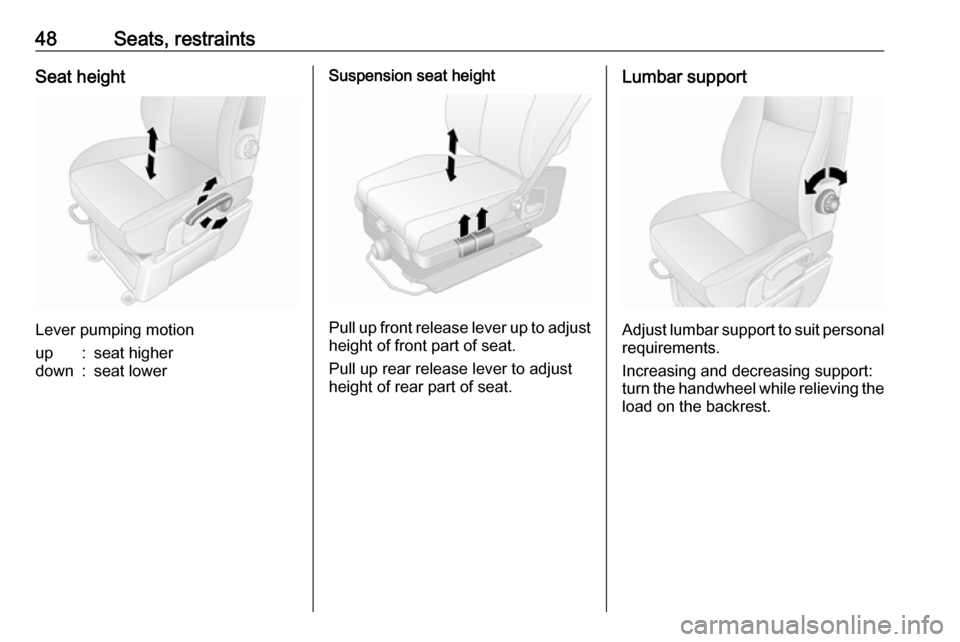
48Seats, restraintsSeat height
Lever pumping motion
up:seat higherdown:seat lowerSuspension seat height
Pull up front release lever up to adjustheight of front part of seat.
Pull up rear release lever to adjust height of rear part of seat.
Lumbar support
Adjust lumbar support to suit personal requirements.
Increasing and decreasing support:
turn the handwheel while relieving the load on the backrest.
Page 60 of 351

58Seats, restraints9Warning
The lap belt must be positioned as
low as possible across the pelvis
to prevent pressure on the
abdomen.
Airbag system
The airbag system consists of a
number of individual systems
depending on the scope of
equipment.
When triggered the airbags inflate
within milliseconds. They also deflate
so quickly that it is often unnoticeable
during the collision.9 Warning
As the airbag system deploys in an
explosive manner, repairs must be
performed by skilled personnel
only.
9 Warning
Adding accessories that change
the vehicle's frame, bumper
system, height, front end or side
sheet metal, may keep the airbag
system from working properly. The operation of the airbag system can
also be affected by changing any
parts of the front seats, seat belts,
airbag sensing and diagnostic
module, steering wheel,
instrument panel, inner door seals including the speakers, any of the
airbag modules, ceiling or pillar
trim, front sensors, side impact
sensors or airbag wiring.
Notice
The airbag systems and belt
pretensioner control electronics are
located in the centre console area.
Do not put any magnetic objects in
this area.
Do not affix any objects onto the
airbag covers and do not cover them with other materials. Have damagedcovers replaced by a workshop.
Each airbag is triggered only once.
Have deployed airbags replaced by
a workshop. Furthermore, it may be
necessary to have the steering
wheel, the instrument panel, parts of
the panelling, the door seals,
handles and the seats replaced.